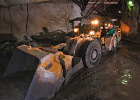Cameco’s creative innovation

1 of 2Crews move the muck away underground at the Cigar Lake remediation project four months after the mine was pumped out. — photo courtesy Cameco2
1 of 2Crews move the muck away underground at the Cigar Lake remediation project four months after the mine was pumped out. — photo courtesy Cameco
The remediation at the Cigar Lake Mine, located in the Athabasca Basin in northern Saskatchewan, is a remarkable story of Cameco's creative innovation and tenacity. This project earned Cameco the 2011 Exceptional Engineering/Geoscience Award from the Association of Professional Engineers & Geoscientists of Saskatchewan.
The Cigar Lake Mine is the world's largest undeveloped high-grade uranium deposit; Cameco, a world leader in uranium production, holds controlling ownership.
Grant Goddard, vice-president of Saskatchewan Mining North at Cameco, said that the company plans for Cigar Lake to begin mining its first ore by mid 2013. It will take another four years for the mine to reach its full production of approximately 18 million pounds of Uranium annually.
“The Cigar Lake property is a very important part of our overall strategy to grow the company,” said Goddard.
Goddard said that the project, which officially began in 2005, was progressing along well until there was an inflow of water in 2006, and again unexpectedly in 2008.
“We decided at that point of time that we could treat the water and pump it, but it was coming in at a rate that would exceed our treated-water release permit, so we made the decision to allow the mine to refill,” said Goddard. “Thus the story unfolds. The team were taken aback certainly, but there was amazing resiliency and spirit . . . and they bounced back and didn't panic.”
A variety of ways were considered to explore the reason for the inflow, but what the team found most useful was deploying Remote Operating Vehicles (ROVs) underground. The ROVs were modified to sense different things underground such as water temperature.
“The water in the mine itself was around 8 C and the water coming in was about 7.3 C," said Goddard. "That subtle difference fundamentally led us to find the inflow location."
He said the next challenge was to seal the inflow.
“It was located about 20 metres or less from the shaft," he said, "and we had found from the remediation in 2006 that when we drilled from surface and pumped concrete underground to fill the inflow, the material didn't stay in one nice block and flowed quite far. The concern here was that the concrete grout mixture could potentially flow down the shaft, which could lead to more problems and repairs later.”
One of the ideas the team came up with was to seal the tunnel using some form of bag or inflatable tunnel seal. Goddard said that the bag was not new technology, but the scale for which they were using it—how and what they were using it for, and the fact that they were placing it remotely—was really the unique aspect to the project and the core of the innovation.
"The bag that was used was custom made so that the ROV could manipulate the bag,” said Goddard.
The team used the ROVs to move all the sand and equipment, place the bag, fill it and backfill the area with grout. This was all done under water. Goddard said that as the ROV moved around, it would stir up sand. He likened driving the ROV from the surface to driving around in a snowstorm at night.
Goddard said that working with the ROVs was like marionette work and often like playing a video game.
“The sand and fine material had to be removed to get a good foundation for the grout," said Goddard. "A dredge pump was created so it could be used by the ROV. A water jet was in one hand (of the ROV) and a dredge head was in the other."
Goddard said they designed what they called a hot stab skid to receive the bag once the ROVs pulled it down the shaft. The hot stab skid was connected up to cables that had been inserted through drill holes created by surface drilling. Once everything was in place, the skid was connected to the bag and the cables, and this allowed surface operators to drag the bag to where they wanted it placed at the end of the tunnel.
“Water was pumped from the surface into the bag," said Goddard. "The concrete was then pumped, which would displace the water through pressure-release valves. The bag ended up filled with concrete to harden up. Meanwhile, the ROV was lined up to watch it.”
Goddard said the team practised everything on the surface and simulated the event. The bag was put in place in the late fall of 2009. The mine inflow areas were sealed up by 2009 and all the mine water was pumped out by early 2010.
“To physically go and stand there after all this effort was, for some, pretty emotional," he said. "It was a lot of hard work.
“The teamwork underpinned our whole approach within Cigar Lake and Cameco. It was the creativity of the team, the tenacity and the passion to carry (the project) out, and today we are in a position to move forward successfully. So we are pretty proud of it.”



